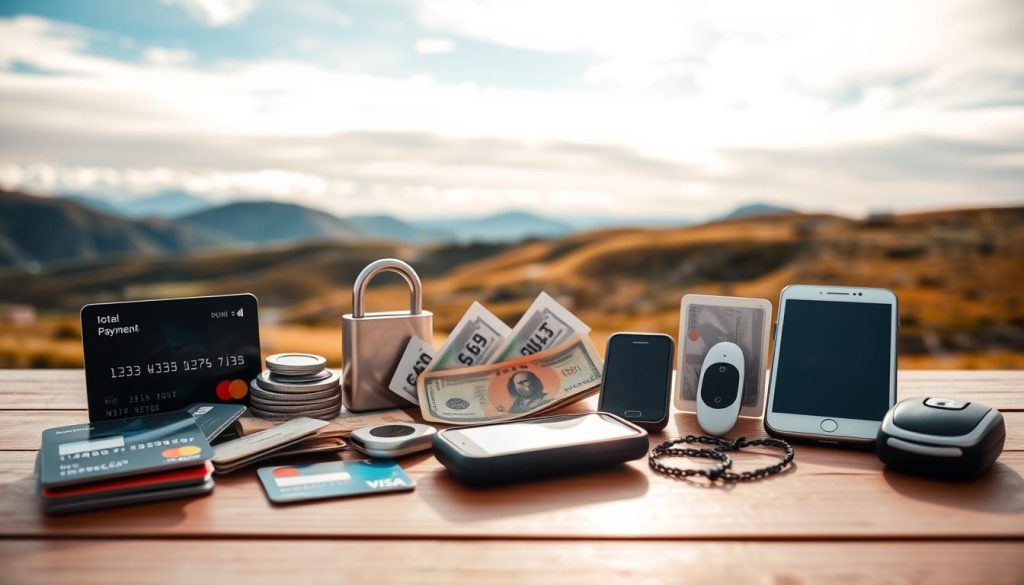✓ Accommodations✓ Flights✓ Rental Cars
Did you know that 89% of businesses rely on their payables team to manage cross-border currency processes? This highlights the importance of understanding currency dynamics, especially when traveling. Proper planning ensures you avoid unnecessary fees and enjoy a seamless experience.
When visiting a new country, knowing the local currency is crucial. For instance, the Norwegian krone (NOK) is divided into 100 Øre and marked by the symbol “kr”. This knowledge helps you make informed decisions about your money.
Using ATMs or credit cards abroad can save you time and effort. However, it’s essential to check for any hidden fees or charges. Many banks offer multi-currency accounts, which simplify transactions and reduce conversion costs.
By planning your currency needs in advance, you can focus on enjoying your trip. This guide will provide practical tips to manage your money efficiently, ensuring a stress-free travel experience.
Understanding Currency in Svalbard and Jan Mayen
Currency knowledge is your first step toward hassle-free financial management abroad. Knowing the local currency system helps you avoid unnecessary fees and ensures smooth transactions during your travels.
Norwegian Krone: Denominations and Key Features
The Norwegian krone (NOK) is the official currency, divided into 100 Øre. It’s marked by the symbol “kr” and comes in both coins and banknotes. Here’s a quick breakdown:
- Coins: 1, 5, 10, and 20 krone.
- Banknotes: 50, 100, 200, 500, and 1000 krone.
Understanding these denominations makes it easier to handle small transactions. For example, 1 CAD equals approximately 7.78 NOK, so you can quickly estimate costs.

Local ATM Practices and Exchange Rates
ATMs are widely available, but withdrawing smaller amounts can help you avoid high fees. Exchange rates vary between banks and service providers. For instance:
- Interbank Rate: 1 CAD = 7.7822 NOK.
- Wise: 1 CAD = 7.7249 NOK.
- OFX: 1 CAD = 7.6954 NOK.
Always verify international fees with your bank or credit card company. This ensures you’re aware of any hidden charges. For larger transfers, providers like TorFX and OFX offer competitive rates with no limits.
By understanding these practices, you can manage your money effectively and focus on enjoying your trip.
Payment Methods and Traveler Tips
Traveling smart means knowing the best ways to handle your finances. Whether you’re using a credit card or cash, understanding your options ensures a smooth experience. Let’s dive into practical tips to manage your money effectively.

Credit Card Insights and International Fees
Using a credit card abroad is convenient, but it’s essential to check for international fees. Many banks charge a foreign transaction fee, typically 1-3% of the purchase amount. Always verify these charges with your bank before your trip.
Some cards, like those from major providers, offer no foreign transaction fees. These can save you money on every purchase. Additionally, notify your bank of your travel plans to avoid declined transactions.
“A credit card with no foreign fees is a traveler’s best friend.”
Managing Cash and Currency Exchange Effectively
While cards are convenient, cash is still king in many places. Exchange rates vary, so compare rates at local banks or ATMs. Avoid currency exchange booths in tourist areas—they often offer less favorable rates.
Carry small amounts of cash for daily expenses. This reduces the risk of losing large sums. For larger amounts, consider using a multi-currency account or digital wallet for secure transactions.
By balancing card and cash payments, you can enjoy a hassle-free trip. Remember, a little planning goes a long way in managing your finances abroad.
Svalbard and Jan Mayen: Ultimate Travelers Guide to Currencies & Payments
Planning your currency needs before traveling can save you time and money. Understanding your financial requirements ensures a smooth experience abroad. Start by estimating how much cash you’ll need for daily expenses. This helps avoid over-carrying or running short.
Digital payment options like credit cards and mobile wallets are convenient. However, always check for international fees. Some banks charge up to 3% per transaction. Choosing a card with no foreign fees can save you significantly.

Carry a mix of cash and cards for flexibility. While cards are widely accepted, cash is still essential in some areas. Exchange rates vary, so compare rates at local banks or ATMs. Avoid currency exchange booths in tourist spots—they often have higher fees.
How to Plan Your Currency Needs Abroad
Begin by researching the local payment practices of your destination. For example, some markets prefer cash, while others lean heavily on digital payments. Knowing this helps you prepare accordingly.
Create a budget for your trip. Include daily expenses, transportation, and emergencies. This ensures you have enough funds without overspending. Use a multi-currency account to simplify transactions and reduce conversion costs.
Notify your bank of your travel plans to avoid declined transactions. Some banks block foreign payments as a security measure. Staying informed about local banking practices can prevent unnecessary hassles.
By planning ahead, you can avoid unexpected charges and exchange rate surprises. A little preparation goes a long way in ensuring a stress-free travel experience.
Global Multi-Currency Payment Solutions for International Travelers
Managing your money across borders has never been easier with modern payment solutions. Whether you’re a frequent traveler or a business owner, multi-currency tools simplify cross-border transactions. These systems offer flexibility, reduced fees, and real-time tracking to keep you in control.

Leveraging Digital Payment Gateways and Automation
Digital payment gateways are revolutionizing how we handle international transactions. They automate processes like currency conversion and rate locking, ensuring you get the best value at the point of purchase. For example, platforms like Wise use the mid-market exchange rate, saving you money on fees.
Automation also reduces manual intervention, making payments faster and more transparent. Real-time tracking and reporting keep you informed at every step. This is especially useful for businesses managing multiple currencies across different markets.
“Automation in payments ensures accuracy and efficiency, giving you peace of mind.”
Multi-currency accounts are another game-changer. They allow you to hold and manage funds in various currencies, simplifying international transactions. Providers like Starling offer accounts in euros and US dollars with no extra fees, making them a cost-effective option.
When choosing a payment service, reliability is key. Look for providers with strong security measures and competitive rates. This ensures your transactions are safe, fast, and efficient. By leveraging these tools, you can focus on your journey or business growth without worrying about financial hassles.
Conclusion
Understanding how to manage your finances abroad ensures a smooth and stress-free journey. This guide has highlighted the importance of planning your currency needs and choosing the right payment methods. By leveraging digital tools like multi-currency accounts, you can avoid unnecessary fees and simplify transactions.
Always research local rates and banking practices before your trip. Notify your bank of your travel plans to prevent declined transactions. Carrying a mix of cash and cards offers flexibility, while digital wallets provide added convenience.
With proper planning, you can focus on enjoying your trip without financial worries. Use this guide as a reference to make informed decisions and optimize your travel budget. Safe travels!
The above is subject to change.
Check back often to TRAVEL.COM for the latest travel tips and deals.





